Are the Houthis dragging us toward a global trade crisis?
 First published in spiked, January 2023
First published in spiked, January 2023The attacks on Red Sea ships are having a dangerously outsized impact on the global economy
Since the outbreak of the Israel-Hamas war in October, Yemen’s Houthi rebels have been attacking container ships and energy tankers in the Red Sea. These attacks, carried out in solidarity with Hamas, have already started to wreak havoc with global trade. At least 18 shipping lines have started rerouting their vessels to avoid Houthi attacks. The US and UK have even threatened a wave of airstrikes in response.
The reason the Houthis have provoked such a strong reaction, and have been able to inflict such disproportionate damage, is that the Red Sea sits on a vital choke point. The narrow Bab el-Mandeb Strait, which connects the Gulf of Aden in Yemen to the Red Sea and then the Suez Canal, is critical for trade between Europe and Asia.
There are a lot of crucial choke points around the globe. Following Barack Obama’s 2011 ‘pivot’ toward Asia, the US had been devoting huge efforts to keeping maritime trade flowing in the South China Sea, and especially in the Taiwan Strait next to China.
Right now, while passage through the Suez Canal is being threatened by the Houthis, another choke point in central America is under pressure. A drought around the Panama Canal has drastically limited the number of ships that can pass through it. All in all, perhaps as much as a third of world trade could potentially be disrupted by the problems in the Suez and Panama canals alone.
The immediate impact of all this disruption? Inflation. To sail from Singapore to Rotterdam via the Cape of Good Hope, rather than the Suez Canal, adds 3,300 miles to the journey – roughly an extra 40 per cent. That can only add to shipping charges, and thus to cargo prices.
Our economies could also be hit by slower growth. Trade has become increasingly vital to international prosperity in recent decades. Between 1970 and today, world trade has risen in importance from the equivalent of 25 per cent of global GDP to 74 per cent. In a world where the unimpeded flow of goods and commodities is taken for granted, disruption to trade has outsized consequences.
Perhaps the biggest danger is to energy security. More than 50 per cent of the world’s trade in liquified natural gas (LNG) flows through the Suez Canal. Similarly, around 40 per cent of all oil that is produced is traded via just three choke points around the Indian Ocean – namely, the strait of Bab-el-Mandeb, the strait of Hormuz (between Iran and the United Arab Emirates) and the strait of Malacca (between the Indonesian island of Sumatra and the Malay Peninsula). For big oil importers such as China, Japan and India, Hormuz is particularly critical. More than 20 per cent of global petroleum liquids consumption has to go through the eye of that needle.
Choke points aren’t all maritime. It’s true that the logistical importance of Pakistan’s Khyber Pass, a land-based bottleneck, has receded since the West’s withdrawal from Afghanistan. Now, though, many eyes are focussed on the Isthmus of Perekop, a strip of land just three to five miles wide that hooks up Russian-occupied Crimea to Ukraine.
Perhaps the easiest choke point to forget is the one that connects us all to the internet. There are 16 submarine cables running from the Indian Ocean to the Mediterranean Sea via the Suez Canal. This makes it the chief digital nexus between Europe and Asia.
If the Houthis’ attacks have demonstrated anything, it is that the disruption of just a single choke point can have vast global ramifications. The foundations of our global economy are clearly far more precarious than we tend to realise.
Photo: File ID 52068467 | © Igor Groshev | Dreamstime.com
@jameswoudhuysen I use my bicycle every day. Exercise and access to shopping without any parking meters and all that fuzz. But alfa-cyclists are the worst. They are competing at 40 mph and always acting rudely to get where they are going.
A PRO-CAR CYCLIST WRITES: 12-1pm tomorrow on #R4, will be talking bikes, cars, pedestrians, public transport – and #JeremyVine
Stimulating piece on the #CrisisOfCustomerService by clever @ClaerB @FT.
All that Clinton-era #CustomerExperience guff was always for the birds - certainly compared with, er, price.
The new thang? Often there is NO service - and thus no #CX!
Articles grouped by Tag
Bookmarks
Innovators I like

Robert Furchgott – discovered that nitric oxide transmits signals within the human body

Barry Marshall – showed that the bacterium Helicobacter pylori is the cause of most peptic ulcers, reversing decades of medical doctrine holding that ulcers were caused by stress, spicy foods, and too much acid

N Joseph Woodland – co-inventor of the barcode

Jocelyn Bell Burnell – she discovered the first radio pulsars

John Tyndall – the man who worked out why the sky was blue

Rosalind Franklin co-discovered the structure of DNA, with Crick and Watson

Rosalyn Sussman Yallow – development of radioimmunoassay (RIA), a method of quantifying minute amounts of biological substances in the body

Jonas Salk – discovery and development of the first successful polio vaccine

John Waterlow – discovered that lack of body potassium causes altitude sickness. First experiment: on himself

Werner Forssmann – the first man to insert a catheter into a human heart: his own

Bruce Bayer – scientist with Kodak whose invention of a colour filter array enabled digital imaging sensors to capture colour

Yuri Gagarin – first man in space. My piece of fandom: http://www.spiked-online.com/newsite/article/10421

Sir Godfrey Hounsfield – inventor, with Robert Ledley, of the CAT scanner

Martin Cooper – inventor of the mobile phone

Thomas Tuohy – Windscale manager who doused the flames of the 1957 fire

Eugene Polley – TV remote controls

George Devol – 'father of robotics’ who helped to revolutionise carmaking



0 comments